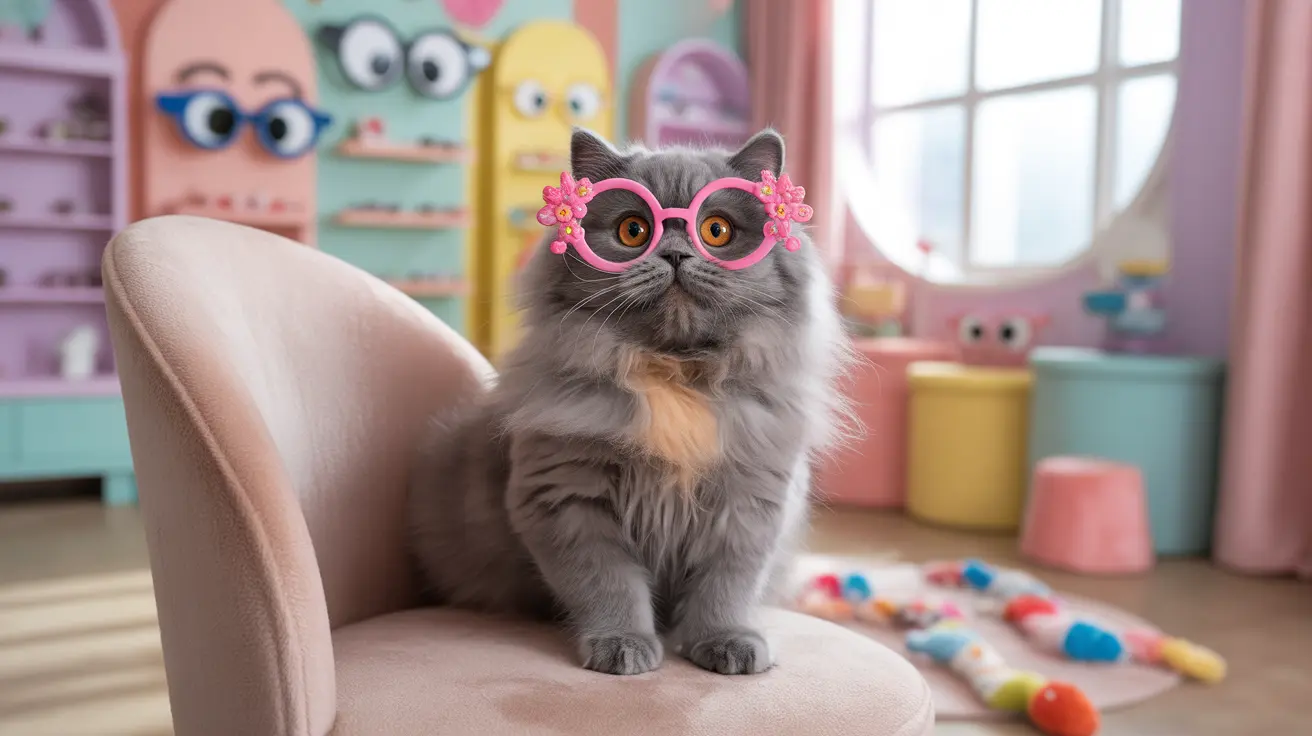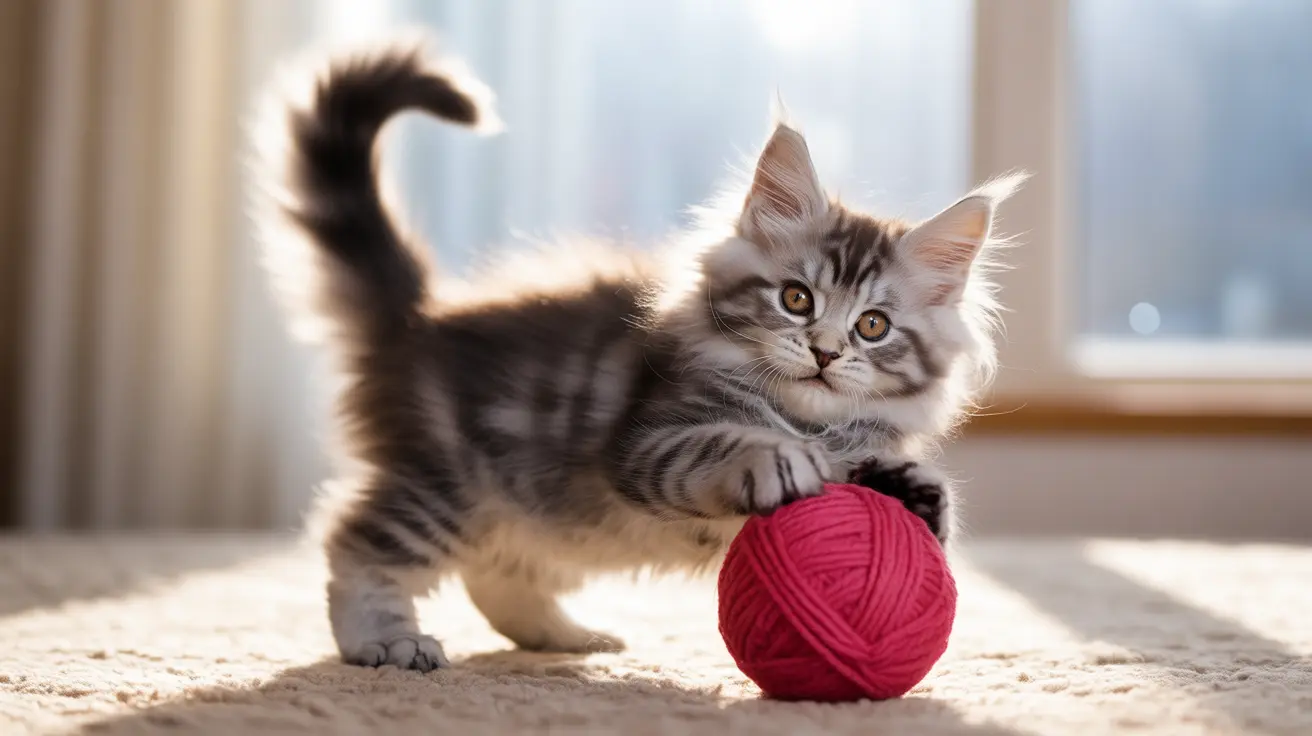How a Cat Helps Children Wear Glasses Confidently: Meet Truffles, the Therapeutic Eyewear Companion
For many children, receiving their first pair of glasses can be an emotionally challenging experience filled with anxiety, self-consciousness, and resistance. The fear of looking different or being teased by peers often creates barriers to accepting necessary vision correction. However, one remarkable tuxedo cat named Truffles has revolutionized how children approach wearing glasses, transforming a potentially stressful experience into an engaging and confidence-building journey.
At A Child's Eyes, a specialized children's optical shop, Truffles serves as the honorary eyeglass instructor, wearing her own colorful glasses to demonstrate that eyewear can be both functional and fashionable. This innovative approach to pediatric vision care represents a growing understanding of how animal-assisted therapy can address the psychological and emotional barriers children face when adapting to medical devices like glasses.
Through her unique role as a therapeutic companion, this extraordinary cat helps children wear glasses confidently while normalizing the experience of vision correction. Her presence has proven invaluable in creating a supportive, non-threatening environment where young patients can overcome their fears and embrace their new glasses with pride.
Truffles: The Pioneering Therapeutic Cat in Pediatric Vision Care
Truffles, a tuxedo cat from Pennsylvania, has captured hearts worldwide as she sports specially designed eyeglasses in a children's optical shop. Unlike most cats who wouldn't tolerate wearing glasses, Truffles has been carefully trained to put on and take off her glasses independently, making the interaction natural and less stressful for the animal. This remarkable ability allows her to serve as a living example for children who are hesitant about wearing their own glasses.
Working alongside optician Danielle at A Child's Eyes, Truffles wears a variety of specially made small glasses, including frames designed for color blindness treatment. She even dons an eye patch when necessary to normalize treatment for various eye conditions that require this type of intervention. Her willingness to model different types of eyewear helps children understand that vision correction comes in many forms and that wearing glasses or eye patches is nothing to be ashamed of.
The cat's presence in the optical shop serves multiple therapeutic purposes. Children who initially resist wearing glasses often find themselves fascinated by Truffles' colorful eyewear collection. This fascination breaks down emotional barriers and creates positive associations with glasses, transforming what could be a traumatic experience into an engaging and educational interaction.
Breaking Down Emotional Barriers: How Truffles Reduces Children's Fear of Glasses
The intimidation factor associated with wearing glasses often stems from children's fear of appearing different or facing potential ridicule from peers. Truffles helps eliminate these concerns by demonstrating that glasses can be stylish, fun, and even admirable. When children see this confident cat proudly wearing her colorful frames, they begin to view glasses as accessories rather than medical necessities that mark them as different.
Interaction with Truffles provides crucial emotional support during what can be a vulnerable time for young patients. The cat's calm presence and willingness to model various eyewear options helps reduce children's anxiety about their upcoming vision correction. This emotional support is particularly valuable for children who may have been teased about their vision problems or who worry about how glasses will change their appearance.
The therapeutic relationship between Truffles and young patients extends beyond simple modeling. Children often engage in conversations about the cat's glasses, asking questions about her different frames and expressing admiration for her stylish choices. These interactions help normalize the experience of wearing glasses while building children's confidence in their own ability to wear eyewear successfully.
The Science Behind Animal-Assisted Therapy in Pediatric Healthcare
Animals like Truffles promote empathy, social skills, and responsibility in children while having a calming, positive effect on their overall well-being. The psychological and emotional benefits of animals in pediatric healthcare settings have been extensively documented, particularly in relation to vision therapy and other medical interventions that require ongoing patient compliance.
Animal-assisted therapy works by reducing stress hormones and increasing the production of mood-enhancing chemicals like serotonin and dopamine. When children interact with therapy animals, their anxiety levels decrease significantly, making them more receptive to medical treatments and more likely to comply with prescribed therapies. In the context of vision care, this means children are more willing to wear their glasses consistently when they associate the experience with positive emotions.
The presence of animals in healthcare settings also helps shift children's focus away from their medical concerns and toward the joy of animal interaction. This distraction technique is particularly effective for children receiving vision therapy, as it reduces the self-consciousness that often accompanies wearing new glasses or eye patches.
Training and Safety Considerations for Therapeutic Animals
Despite the benefits of animal-assisted therapy, experts caution against putting glasses or accessories on pets without proper care and training, as it can be stressful or harmful to the animals. Truffles' success as a therapeutic companion results from careful training that prioritizes her comfort and well-being while ensuring she can safely perform her role as an eyewear model.
The training process for therapeutic animals like Truffles involves gradual acclimation to wearing accessories, positive reinforcement techniques, and careful monitoring to ensure the animal remains comfortable throughout interactions with patients. Professional animal trainers work closely with healthcare providers to develop protocols that maximize therapeutic benefits while maintaining animal welfare standards.
Safety considerations include ensuring that glasses and other accessories are properly fitted to prevent discomfort or injury, limiting wearing time to prevent stress, and continuously monitoring the animal's behavior for signs of distress. Regular veterinary checkups are essential to confirm that therapeutic activities don't negatively impact the animal's health.
Empowering Parents: Supporting Children Through the Glasses Journey
Parents play a crucial role in helping children adapt to wearing glasses confidently, and Truffles' example provides valuable insights for families navigating this transition. The key to success lies in creating positive associations with glasses while addressing children's concerns with empathy and understanding.
One effective approach involves allowing children to choose their own frames, similar to how Truffles models different colorful options. When children have input in selecting their glasses, they develop a sense of ownership and pride in their eyewear choice. This autonomy helps counteract feelings of being forced to wear something they don't want.
Parents can also reinforce positive messaging by celebrating their child's glasses as a tool that will improve their vision and quality of life. Sharing stories about successful people who wear glasses, including beloved fictional characters or celebrities, helps normalize the experience and builds confidence.
Creating Child-Friendly Vision Care Environments
The role of opticians and specialized eyewear stores in making vision care child-friendly and stigma-free cannot be overstated. Facilities like A Child's Eyes, where Truffles works, demonstrate how innovative approaches to pediatric vision care can transform potentially stressful medical appointments into positive, engaging experiences.
Child-friendly optical shops often feature colorful, welcoming environments with age-appropriate decorations, comfortable seating areas, and interactive elements that help children feel at ease. The presence of therapy animals like Truffles adds another layer of comfort, providing emotional support throughout the vision assessment and glasses selection process.
Professional opticians specializing in children's eyewear understand the unique challenges young patients face and develop communication strategies that address these concerns. They work closely with parents to ensure proper fit and comfort while educating children about the importance of consistent glasses wear.
Innovative Global Approaches to Pediatric Vision Care
Truffles represents just one example of innovative methods used worldwide to help children adapt to wearing glasses. Other creative approaches include virtual reality experiences that show children how glasses will improve their vision, peer support programs that connect children who wear glasses, and educational campaigns that celebrate diversity in vision correction.
Some pediatric vision care centers incorporate gaming elements into their services, allowing children to "unlock achievements" for consistent glasses wear or providing rewards for reaching vision improvement milestones. These gamification strategies appeal to children's natural desire for play while reinforcing positive behaviors related to vision care.
Educational initiatives in schools also play a vital role in normalizing glasses wear among children. Programs that teach students about vision differences and the importance of vision correction help create more accepting environments for children who require glasses.
Long-Term Impact of Positive Vision Care Experiences
The confidence-building work that Truffles provides has lasting effects that extend far beyond the initial glasses fitting appointment. Children who develop positive associations with their glasses are more likely to wear them consistently, leading to better vision outcomes and improved academic performance.
Early positive experiences with vision care also establish patterns of health-seeking behavior that benefit children throughout their lives. When children learn to view medical interventions as helpful rather than punitive, they're more likely to comply with future treatments and maintain regular healthcare appointments as adults.
The emotional support provided by therapeutic animals like Truffles helps children develop resilience and coping strategies that serve them well in other challenging situations. These skills contribute to overall emotional intelligence and social competence, benefits that extend far beyond the realm of vision care.
Frequently Asked Questions
How does Truffles help children who are afraid of wearing glasses?
Truffles serves as a role model by wearing colorful glasses herself, showing children that eyewear can be fashionable and fun. Her calm presence and willingness to model different types of glasses helps reduce children's anxiety and creates positive associations with wearing glasses. Children often become fascinated by her various frames, which breaks down emotional barriers and transforms a potentially stressful experience into an engaging interaction.
Is it safe for cats to wear glasses like Truffles does?
While Truffles has been specially trained to wear glasses safely, experts caution that putting accessories on pets without proper care can be stressful or harmful. Truffles' success requires careful training, properly fitted glasses, limited wearing time, and continuous monitoring for signs of discomfort. She's trained to put on and take off glasses independently, making the experience less stressful for her.
What types of glasses does Truffles wear to help different children?
Truffles wears a variety of specially made small glasses, including colorful frames and glasses designed for color blindness treatment. She also wears an eye patch when necessary to normalize treatment for various eye conditions that require this intervention. This variety helps children understand that vision correction comes in many forms and addresses different visual needs.
Can other animals be trained to provide similar support for children with glasses?
Yes, other animals can potentially be trained for therapeutic roles in healthcare environments, but it requires professional training that prioritizes the animal's welfare. The training involves gradual acclimation to accessories, positive reinforcement techniques, and continuous monitoring to ensure the animal remains comfortable. Safety considerations and regular veterinary checkups are essential components of any animal-assisted therapy program.
How can parents help their children feel more confident about wearing glasses?
Parents can support their children by allowing them to choose their own frames, creating positive associations with glasses, and celebrating eyewear as a helpful tool rather than a burden. Sharing stories about successful people who wear glasses, reinforcing the functional benefits of improved vision, and maintaining consistent encouragement all contribute to building children's confidence in wearing glasses.
What makes A Child's Eyes different from regular optical shops?
A Child's Eyes specializes in creating child-friendly, stigma-free vision care experiences. The presence of Truffles as a therapeutic companion, combined with colorful and welcoming environments, helps transform potentially stressful medical appointments into positive experiences. Opticians specializing in children's eyewear understand unique pediatric challenges and develop communication strategies that address children's specific concerns about wearing glasses.
Are there other innovative approaches to help children adapt to wearing glasses?
Yes, innovative methods worldwide include virtual reality experiences showing vision improvement, peer support programs connecting children who wear glasses, gamification strategies with rewards for consistent wear, and educational campaigns celebrating vision diversity. These approaches all aim to normalize glasses wear while making the adaptation process engaging and positive for young patients.
Conclusion
Truffles the therapy cat represents a groundbreaking approach to pediatric vision care that addresses both the practical and emotional aspects of helping children wear glasses confidently. Through her role as an eyewear model and therapeutic companion, she has transformed countless children's experiences with vision correction, turning anxiety into excitement and resistance into acceptance. Her success demonstrates the profound impact that innovative, compassionate approaches to healthcare can have on young patients' well-being and treatment compliance.
The lessons learned from Truffles' therapeutic work extend beyond vision care, offering insights into how animal-assisted therapy can support children facing various medical challenges. As more healthcare providers recognize the value of creating child-friendly, emotionally supportive treatment environments, programs like those at A Child's Eyes will likely become increasingly common, ensuring that future generations of children can approach necessary medical interventions with confidence rather than fear.






